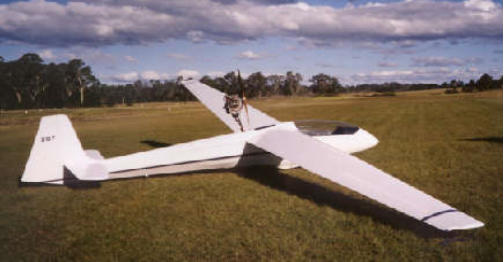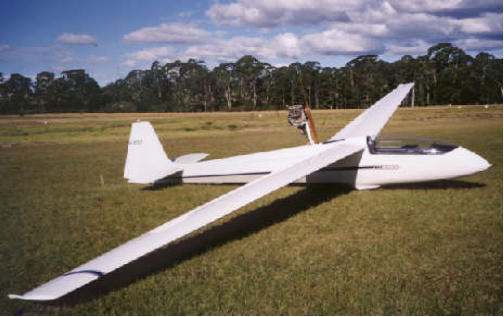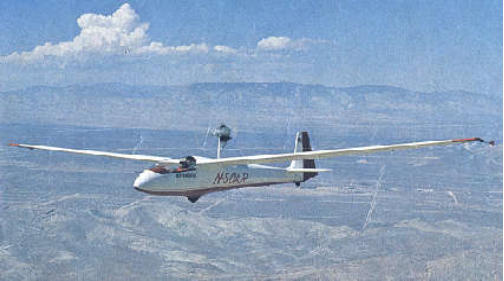













Halter:
E-mail:
Baujahr:
Werknummer:
Standort:
Bemerkung:




Peter Rundle
peter@aerodonetix.com.au
1970
6321
Sydney, Northern Beaches, Australien
The aircraft was shipped to New Orleans, USA where it was registered as N-80AR. The "8" was painted on the fuselage to appear like an "S", thus "SOAR". In the USA
The "8" was painted on the fuselage to appear like an "S", thus "SOAR". In the USA several modifications were made including a steerable tail wheel and sprung wing tip
several modifications were made including a steerable tail wheel and sprung wing tip wheels so that the aircraft could be taxied around. Also an electric starter motor was
wheels so that the aircraft could be taxied around. Also an electric starter motor was added and an
added and an electic fuel pump to help make the engine more reliable. A new fibreglass "Scimitar"
electic fuel pump to help make the engine more reliable. A new fibreglass "Scimitar" propellor was fitted to improve climb performance. Later when the aircraft was
propellor was fitted to improve climb performance. Later when the aircraft was repainted the owner sprayed the wings and fuselage with a polyester filler and profiled
repainted the owner sprayed the wings and fuselage with a polyester filler and profiled the wings. It was claimed
the wings. It was claimed that the performance was improved to be similar to a standard Cirrus. However the
that the performance was improved to be similar to a standard Cirrus. However the flying weight of the aircraft was now 415kg, some 30kg heavier than original.
flying weight of the aircraft was now 415kg, some 30kg heavier than original. The aircraft was sold in Nov 1988 and went to New Zealand where it was registered as
The aircraft was sold in Nov 1988 and went to New Zealand where it was registered as ZK-GOT. In order to obtain a certificate of airworthiness the flying speeds had to be
ZK-GOT. In order to obtain a certificate of airworthiness the flying speeds had to be reduced because of the excessive weight. Also after a number of years the engine
reduced because of the excessive weight. Also after a number of years the engine pylon cracked and had to be replaced. This was because of the fibreglass propellor
pylon cracked and had to be replaced. This was because of the fibreglass propellor which was nearly twice as heavy as a wooden one.
which was nearly twice as heavy as a wooden one. In Feb 1999 the aircraft was shipped to Australia to become VH-ZOT. Again the
In Feb 1999 the aircraft was shipped to Australia to become VH-ZOT. Again the excessive weight proved to be a problem and the fibreglass propellor and electric start
excessive weight proved to be a problem and the fibreglass propellor and electric start (and large battery) had to be removed in order for the aircraft to obtain a certificate of
(and large battery) had to be removed in order for the aircraft to obtain a certificate of airworthiness. After only a few flights the original Hirth engine developed a crankcase
airworthiness. After only a few flights the original Hirth engine developed a crankcase leak
which caused oil to cover the points and stop the engine. It was decided to replace the
leak
which caused oil to cover the points and stop the engine. It was decided to replace the engine and refurbish the aircraft. The polyester filler was removed from the fuselage
engine and refurbish the aircraft. The polyester filler was removed from the fuselage and wings, saving some 20kg of weight. A new MZ201 dual ignition, twin cylinder two-
and wings, saving some 20kg of weight. A new MZ201 dual ignition, twin cylinder two- stroke was fitted and a solar panel was added to keep the battery charged when
stroke was fitted and a solar panel was added to keep the battery charged when soaring. The aircraft has now been flown a few times with the new engine and it
soaring. The aircraft has now been flown a few times with the new engine and it appears to be very good. Hopefully it will see a lot more soaring in the near future.
appears to be very good. Hopefully it will see a lot more soaring in the near future.
 The "8" was painted on the fuselage to appear like an "S", thus "SOAR". In the USA
The "8" was painted on the fuselage to appear like an "S", thus "SOAR". In the USA several modifications were made including a steerable tail wheel and sprung wing tip
several modifications were made including a steerable tail wheel and sprung wing tip wheels so that the aircraft could be taxied around. Also an electric starter motor was
wheels so that the aircraft could be taxied around. Also an electric starter motor was added and an
added and an electic fuel pump to help make the engine more reliable. A new fibreglass "Scimitar"
electic fuel pump to help make the engine more reliable. A new fibreglass "Scimitar" propellor was fitted to improve climb performance. Later when the aircraft was
propellor was fitted to improve climb performance. Later when the aircraft was repainted the owner sprayed the wings and fuselage with a polyester filler and profiled
repainted the owner sprayed the wings and fuselage with a polyester filler and profiled the wings. It was claimed
the wings. It was claimed that the performance was improved to be similar to a standard Cirrus. However the
that the performance was improved to be similar to a standard Cirrus. However the flying weight of the aircraft was now 415kg, some 30kg heavier than original.
flying weight of the aircraft was now 415kg, some 30kg heavier than original. The aircraft was sold in Nov 1988 and went to New Zealand where it was registered as
The aircraft was sold in Nov 1988 and went to New Zealand where it was registered as ZK-GOT. In order to obtain a certificate of airworthiness the flying speeds had to be
ZK-GOT. In order to obtain a certificate of airworthiness the flying speeds had to be reduced because of the excessive weight. Also after a number of years the engine
reduced because of the excessive weight. Also after a number of years the engine pylon cracked and had to be replaced. This was because of the fibreglass propellor
pylon cracked and had to be replaced. This was because of the fibreglass propellor which was nearly twice as heavy as a wooden one.
which was nearly twice as heavy as a wooden one. In Feb 1999 the aircraft was shipped to Australia to become VH-ZOT. Again the
In Feb 1999 the aircraft was shipped to Australia to become VH-ZOT. Again the excessive weight proved to be a problem and the fibreglass propellor and electric start
excessive weight proved to be a problem and the fibreglass propellor and electric start (and large battery) had to be removed in order for the aircraft to obtain a certificate of
(and large battery) had to be removed in order for the aircraft to obtain a certificate of airworthiness. After only a few flights the original Hirth engine developed a crankcase
airworthiness. After only a few flights the original Hirth engine developed a crankcase leak
which caused oil to cover the points and stop the engine. It was decided to replace the
leak
which caused oil to cover the points and stop the engine. It was decided to replace the engine and refurbish the aircraft. The polyester filler was removed from the fuselage
engine and refurbish the aircraft. The polyester filler was removed from the fuselage and wings, saving some 20kg of weight. A new MZ201 dual ignition, twin cylinder two-
and wings, saving some 20kg of weight. A new MZ201 dual ignition, twin cylinder two- stroke was fitted and a solar panel was added to keep the battery charged when
stroke was fitted and a solar panel was added to keep the battery charged when soaring. The aircraft has now been flown a few times with the new engine and it
soaring. The aircraft has now been flown a few times with the new engine and it appears to be very good. Hopefully it will see a lot more soaring in the near future.
appears to be very good. Hopefully it will see a lot more soaring in the near future.














